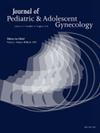19. 新生儿子宫出血与子宫内膜异位症相关的出生因素
IF 1.7
4区 医学
Q3 OBSTETRICS & GYNECOLOGY
引用次数: 0
摘要
sampson的月经逆行理论被认为是子宫内膜异位症的一个重要起源,但并不能解释所有的子宫内膜异位症。特别是发生在青春期之前和期间的子宫内膜异位症,称为早发性子宫内膜异位症,可能是新生儿子宫出血(NUB)现象,因为它可能是第一次逆行性月经出血,发生在产后第7天左右。由于NUB更常见于足月后或高血压并发症妊娠后出生的新生儿,子宫内膜异位症在生命后期可能与胎龄有关,并且在高血压相关并发症妊娠后出生的妇女中可能显示出更高的患病率。方法数据取自丹麦健康登记(更新日期为2023年)和医疗出生登记(1977-1999年丹麦新生儿)。将对患有和没有子宫内膜异位症的妇女进行比较。使用横断面和纵向模型,我们比较了病例和对照组中以下参数的患病率:胎龄、出生体重、母亲在怀孕期间诊断的高血压疾病,即妊高征、先兆子痫、HELLP。结果681970例子宫颈检查结果分为无子宫内膜异位症组(n=667524)和有子宫内膜异位症组(n=14446)。参数后项呈显著负相关。孕龄41周后出生的子宫内膜异位症女婴较少。RR=0.93 (95% CI 0.90-0.96), p<;0.001. 患有和不患有子宫内膜异位症的怀孕后出生的所有高血压疾病合并的女儿的患病率相似。RR= 1,000 (95% CI 0.92-1.08), p = NS。然而,在只有高血压或先兆子痫的组中,女儿患子宫内膜异位症的比例略高。RR=1.07 (95% CI 1.00-1.15) p=0.0495。这种差异在高血压或先兆子痫和产后出生的女儿患子宫内膜异位症的比例更高的组中更为明显。RR = 1.19 (95% CI 1.02-1.39) p=0.03。这些都是初步结果,目前正在对这些小组进行全面评估。结论初步结果并不能直接支持NUB作为晚年子宫内膜异位症起源的理论。高血压和先兆子痫可能与子宫内膜异位症有关。本文章由计算机程序翻译,如有差异,请以英文原文为准。
19. Birth Factors related to Endometriosis later in life in the light of Neonatal Uterine Bleeding (NUB)
Background
Sampson's theory of Retrograde menstruation is regarded as an important origin of endometriosis but does not explain all cases of endometriosis. Especially, endometriosis occurring before and during puberty, referred to as early-onset endometriosis which might be explained by the phenomenon of neonatal uterine bleeding (NUB), as it is possibly the first retrograde menstrual bleeding and occurring around the 7th day postpartum. As NUB is more often seen in neonates born post term or after hypertension induced complicated pregnancies, endometriosis later in life might be correlated with gestational age and may show a higher prevalence in woman born after a hypertension-related complicated pregnancy.
Methods
Data were extracted from the Danish Health Register (update 2023) and the Medical Birth Register (Danish new-borns from 1977-1999). Women with and without endometriosis will be compared. Using cross-sectional and longitudinal models we compared the prevalence of the following parameters in both cases and controls: gestational age, birth weight, hypertensive disorders diagnosed in the pregnancy of the mother i.e. pregnancy induced hypertension, preeclampsia, HELLP.
Results
A total of 681970 daughters could be evaluated divided in two groups: no endometriosis (n=667524) and with endometriosis (n=14446). A significant negative correlation was seen for the parameter post term. Less daughters with endometriosis were born after the gestational age of 41 weeks. RR=0.93 (95% CI 0.90-0.96) and p< 0.001. The prevalence of daughters with and without endometriosis, born after a pregnancy with all hypertensive disorders combined was similar. RR=1,00 (95% CI 0.92-1.08) and p NS. However, in the group with only hypertension or pre-eclampsia there was a slightly higher prevalence of daughters with endometriosis. RR=1.07 (95% CI 1.00-1.15) p=0.0495. This difference was even more clear in the group with hypertension or pre-eclampsia and born postterm showing a higher prevalence of daughters with endometriosis. RR = 1.19 (95% CI 1.02-1.39) p=0.03. These are preliminary results and a full evaluation of the groups is in progress at the moment.
Conclusions
Preliminary results not directly support the theory of NUB as an origin of endometriosis later in life. Hypertension and preeclampsia might have an association with endometriosis.
求助全文
通过发布文献求助,成功后即可免费获取论文全文。
去求助
来源期刊
CiteScore
3.90
自引率
11.10%
发文量
251
审稿时长
57 days
期刊介绍:
Journal of Pediatric and Adolescent Gynecology includes all aspects of clinical and basic science research in pediatric and adolescent gynecology. The Journal draws on expertise from a variety of disciplines including pediatrics, obstetrics and gynecology, reproduction and gynecology, reproductive and pediatric endocrinology, genetics, and molecular biology.
The Journal of Pediatric and Adolescent Gynecology features original studies, review articles, book and literature reviews, letters to the editor, and communications in brief. It is an essential resource for the libraries of OB/GYN specialists, as well as pediatricians and primary care physicians.

 求助内容:
求助内容: 应助结果提醒方式:
应助结果提醒方式:


